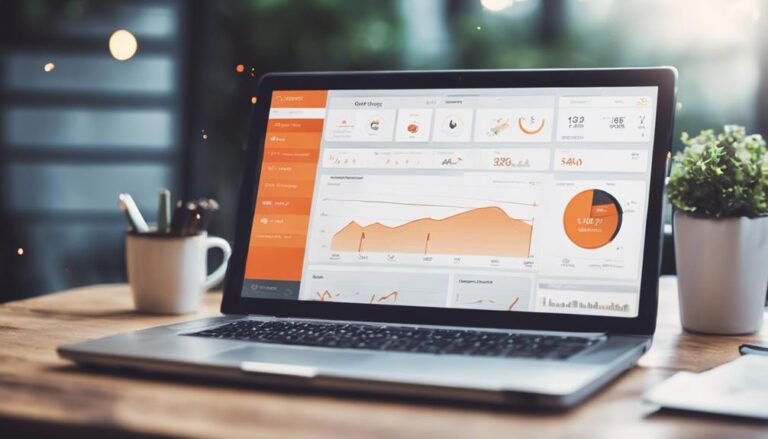Free Social Listening Tools
Are you looking for free social listening tools to boost your online presence? Look no further!
In this article, we’ll show you the top free tools that can help you monitor and analyze conversations happening on social media.
By utilizing these tools, you’ll gain valuable insights into your audience, competitors, and industry trends.
So, get ready to take your social media strategy to the next level with these powerful and cost-effective tools.
Let’s dive in!
Key Takeaways
- Hootsuite, Google Alerts, TweetDeck, and Social Mention are top free social listening tools.
- These tools allow businesses to track and analyze social media mentions, monitor brand perception, and engage with the audience.
- Social listening tools help businesses enhance their brand reputation by addressing negative feedback promptly and tailoring marketing strategies to resonate with the audience.
- Setting up and getting started with social listening tools involves comparing costs and functionality, defining goals, customizing tracking, and regularly analyzing data to inform marketing strategies and improve customer experiences.
Understanding Social Listening
Now it’s time for you to understand social listening.
Social listening is a powerful tool that allows businesses to monitor customer sentiment and gain insights from social media conversations. By actively monitoring social media platforms, businesses can tap into the opinions, feedback, and emotions of their customers. This helps them understand how their brand is perceived, identify trends, and make informed business decisions.
Customer sentiment refers to the positive or negative feelings and opinions expressed by customers towards a brand or product. Social media monitoring involves tracking and analyzing these sentiments across various social media platforms such as Twitter, Facebook, and Instagram.
With social listening, businesses can identify customer pain points, address issues promptly, and improve their overall customer experience. It enables them to proactively engage with customers, respond to queries, and resolve complaints in real-time.
Social listening also helps businesses stay updated on industry trends, competitor activities, and consumer preferences. By monitoring conversations around relevant keywords, businesses can identify emerging trends, spot opportunities, and stay ahead of the competition.
Benefits of Social Listening Tools
Are you looking to gain valuable insights about your customers and improve your brand reputation?
Social listening tools can help you achieve these goals. By monitoring online conversations and analyzing trends, you can understand your customers’ needs and preferences better, allowing you to tailor your products and services to meet their expectations.
Additionally, social listening tools enable you to quickly address any negative feedback or concerns, helping you maintain a positive brand reputation.
Improved Customer Insights
You can gain valuable customer insights by using social listening tools. These tools allow you to monitor and analyze online conversations about your brand, products, and industry. By listening to what your customers are saying, you can gather important feedback and identify trends and patterns that can inform your marketing strategies and business decisions.
Here are some ways social listening tools can help you gain improved customer insights:
| Customer Feedback | Market Research | Competitor Analysis |
|---|---|---|
| Monitor customer sentiment and opinions about your brand. | Identify emerging market trends and consumer preferences. | Track your competitors’ online presence and customer perceptions. |
| Respond quickly to customer complaints or issues. | Gather data on customer needs and preferences for new product development. | Benchmark your brand against competitors and identify areas for improvement. |
| Identify influencers and brand advocates to engage with. | Analyze customer conversations and sentiment to evaluate the effectiveness of marketing campaigns. | Stay up-to-date with industry news and developments. |
| Identify gaps in the market and potential opportunities for expansion. | Identify key influencers and thought leaders in your industry. | Identify potential threats and challenges posed by competitors. |
Social listening tools provide a wealth of data and insights that can help you better understand your customers and make more informed business decisions. By leveraging these tools, you can stay ahead of the competition and deliver a customer experience that meets and exceeds expectations.
Enhanced Brand Reputation
One of the benefits of using social listening tools is that they can enhance your brand reputation. By monitoring online conversations and mentions of your brand, you can gain valuable insights into how your brand is perceived by your target audience.
This knowledge allows you to make informed decisions and take proactive steps to improve your brand perception. When you actively listen to what your customers are saying, you can address any negative feedback or concerns promptly, demonstrating your commitment to customer satisfaction.
This can help build trust and loyalty among your customers, leading to increased customer retention and advocacy. Additionally, by understanding the sentiments and preferences of your audience, you can tailor your marketing strategies and messages to resonate with them better, further boosting your brand reputation.
Top Free Social Listening Tools
Check out these five must-have free social listening tools for monitoring your online presence:
-
Hootsuite: Track and analyze social media mentions, measure the impact of your campaigns, and engage with your audience all in one place.
-
Google Alerts: Receive email notifications whenever your brand or keywords are mentioned online, allowing you to stay informed and respond in real-time.
-
TweetDeck: Monitor and engage with your Twitter audience, create customized streams to track specific keywords or hashtags, and schedule tweets for optimal engagement.
-
Social Mention: Get real-time insights into what people are saying about your brand across various social media platforms, helping you measure the impact of your online presence.
-
Awario: Discover mentions of your brand or products on social media and the web, track sentiment analysis, and engage with your audience to improve customer satisfaction.
These free social listening tools are essential for improving engagement and measuring the impact of your online presence. By monitoring social media mentions, analyzing campaign performance, and engaging with your audience, you can gain valuable insights and make data-driven decisions to enhance your brand’s reputation.
Stay on top of your online presence with these powerful tools and take control of your brand’s narrative.
How to Choose the Right Social Listening Tool
When it comes to choosing the right social listening tool, there are a few key factors you should consider.
Firstly, think about the specific functionalities you need for your business or brand. Are you looking for real-time monitoring, sentiment analysis, or competitor tracking?
Secondly, compare the costs of different tools and weigh them against their functionality. Finding the right balance between cost and features will ensure you get the most value out of your social listening tool.
Key Selection Factors
Are you looking for a social listening tool that meets all your requirements? When choosing the right social listening tool, there are several key selection factors to consider.
Here are five important factors to help you make an informed decision:
-
Cost considerations: Evaluate the pricing plans and determine which one aligns with your budget.
-
Feature comparison: Compare the features offered by different tools and choose the one that provides the functionalities you need.
-
Ease of use: Look for a tool that’s intuitive and user-friendly, ensuring a smooth experience for you and your team.
-
Data accuracy: Ensure that the tool provides accurate and reliable data insights to make informed business decisions.
-
Customer support: Consider the level of customer support offered by the tool’s provider, as it can greatly impact your experience and success with the tool.
Considering these factors will help you choose the right social listening tool that best suits your needs and objectives.
Cost and Functionality Comparison
To make an informed decision, you should compare the cost and functionality of different social listening tools. Conducting a cost comparison is essential to ensure that you’re getting the best value for your money. Look for tools that offer a range of features that align with your specific needs.
Conduct a feature analysis to determine which tools provide the functionality you require. Consider factors such as sentiment analysis, data visualization, and real-time monitoring capabilities. Additionally, assess the scalability of the tools to accommodate your future growth.
Keep in mind that while some tools may offer a lower cost, they may lack certain features or have limitations. It’s crucial to strike a balance between cost and functionality to choose the right social listening tool for your business.
Setting up and Getting Started With Social Listening Tools
Once you’ve familiarized yourself with the available options, start by selecting the social listening tool that best suits your needs. Setting up and getting started with social listening tools can be an exciting and valuable process for your business. Here are five key steps to help you get started with social media monitoring:
-
Define your goals: Determine what you want to achieve with social listening. Are you looking to monitor brand mentions, track customer sentiment, or identify industry trends? Clearly define your objectives to guide your tool selection and data analysis.
-
Choose the right tool: Consider factors such as the platforms you want to monitor, the depth of analysis you require, and your budget. Look for tools that offer comprehensive features, easy-to-use interfaces, and reliable customer support.
-
Set up your accounts: Once you’ve chosen a tool, create an account and connect your social media profiles. This allows the tool to collect data from your chosen platforms and start monitoring conversations related to your brand.
-
Customize your tracking: Tailor your social listening tool to capture the specific keywords, hashtags, and topics that are relevant to your business. This will ensure that you receive accurate and actionable insights from the data collected.
-
Analyze and take action: Regularly review the data gathered by your social listening tool. Use the insights gained to inform your marketing strategies, improve customer experiences, and make data-driven decisions. Remember, social listening is an ongoing process, so monitor and adjust your approach as needed.
Analyzing and Interpreting Social Listening Data
Start by examining the data collected from your social listening efforts to gain valuable insights and make informed decisions for your business. Analyzing social sentiment is an important aspect of understanding how your brand is perceived online. By measuring the overall sentiment of social media conversations about your brand, you can gauge the level of positivity or negativity surrounding your products or services. This information can help you identify areas that need improvement and highlight what’s working well. Additionally, analyzing social sentiment can provide valuable feedback on customer satisfaction, allowing you to address any issues promptly.
Measuring social media impact is another crucial component of analyzing social listening data. It involves tracking and analyzing key performance indicators (KPIs) such as engagement metrics, reach, and brand mentions. By monitoring these metrics, you can assess the effectiveness of your social media campaigns and determine their impact on your target audience. This information can guide your future marketing efforts and help you optimize your social media strategy.
Leveraging Social Listening for Competitive Analysis
When it comes to competitive analysis, social listening can be a powerful tool for your business.
By monitoring your competitors, you can gain valuable insights into their strategies, campaigns, and customer sentiment.
Additionally, social listening allows you to identify market trends and stay ahead of the competition.
It also helps you improve your brand positioning based on the feedback and preferences of your target audience.
Importance of Competitor Monitoring
You should regularly use social listening tools to monitor your competitors and gain valuable insights for competitive analysis. By keeping a close eye on your competitors’ online presence, you can stay informed about their marketing strategies, customer interactions, and industry trends.
Here are five reasons why competitor monitoring is essential for your business:
-
Identify market gaps and opportunities: By analyzing your competitors’ online conversations, you can uncover untapped markets and areas where you can differentiate yourself.
-
Stay ahead of industry trends: Monitoring your competitors allows you to stay updated on the latest industry trends and adapt your strategies accordingly.
-
Understand your target audience better: By analyzing your competitors’ interactions with their customers, you can gain insights into your target audience’s preferences, pain points, and desires.
-
Benchmark your performance: Monitoring your competitors’ social media metrics allows you to compare your performance and identify areas for improvement.
-
Mitigate risks: By monitoring your competitors, you can anticipate their moves, identify potential threats, and take proactive measures to protect your market share.
Competitor monitoring through social listening tools is an invaluable tool for staying competitive and ensuring the success of your business.
Identifying Market Trends
By leveraging social listening for competitive analysis, you can uncover valuable insights and stay ahead of market trends. Market research and understanding consumer behavior are crucial for any business to succeed.
Social listening tools allow you to monitor conversations happening on social media platforms, providing real-time insights into what consumers are saying about your competitors and the overall market. By analyzing this data, you can identify emerging trends, understand consumer preferences, and anticipate market shifts.
Social listening enables you to track changes in consumer behavior, such as shifts in preferences, buying patterns, and sentiment towards products or brands. This information can help you make informed decisions, adapt your marketing strategies, and stay competitive in today’s dynamic business landscape.
Stay ahead of the curve by harnessing the power of social listening for market trend identification.
Improving Brand Positioning
Leverage social listening to gain a competitive edge and improve your brand positioning. By analyzing conversations and feedback from your target audience, you can refine your brand positioning strategies and stay ahead of the competition.
Here are five ways social listening can help you improve your brand positioning:
-
Understand your audience: Social listening allows you to gather insights about your target audience’s preferences, interests, and pain points. This information can help you tailor your brand message and positioning to resonate with them.
-
Identify competitive advantages: By monitoring conversations about your competitors, you can identify gaps in the market and position your brand as a unique solution to meet customer needs.
-
Track sentiment: Social listening helps you gauge how your brand is perceived in the market. By tracking sentiment, you can make adjustments to your brand positioning to align with customer perceptions.
-
Discover influencers: Social listening allows you to identify influencers who align with your brand values and target audience. Partnering with influencers can boost your brand’s visibility and credibility in the market.
-
Stay updated on trends: Social listening helps you stay informed about industry trends and changes in customer preferences. This enables you to adjust your brand positioning accordingly and stay relevant in the market.
Leverage the power of social listening to gain insights into your target audience and competitors, and improve your brand positioning strategies for success.
Using Social Listening to Identify Industry Trends
One way to stay ahead of industry trends is by actively monitoring social media conversations. Social listening allows you to gather valuable insights into what consumers are saying about your industry, products, and competitors. By analyzing these conversations, you can identify emerging trends, understand consumer preferences, and make informed decisions for your business.
Here’s a table that showcases the benefits of using social listening for industry forecasting and consumer behavior analysis:
| Benefits of Social Listening | Examples of Insights Gained |
|---|---|
| Identifying emerging trends | Discovering a growing interest in sustainable fashion |
| Understanding consumer preferences | Learning that consumers prefer eco-friendly packaging |
| Monitoring competitor activities | Noticing a competitor launching a new product |
| Identifying potential influencers | Finding influential bloggers in your industry |
| Mitigating potential crises by addressing customer issues | Noticing negative sentiment towards a competitor’s brand |
Integrating Social Listening Into Your Social Media Strategy
To effectively incorporate social listening into your social media strategy, consider integrating it seamlessly with your existing marketing efforts. By doing so, you can gain valuable insights into your audience’s preferences, needs, and sentiments, and use that information to enhance your overall social media presence.
Here are five ways to integrate social listening into your strategy:
-
Monitor conversations: Use social listening tools to track mentions of your brand, industry, or relevant keywords. This will help you stay informed about what people are saying and identify potential opportunities or issues.
-
Engage with your audience: Respond to comments, messages, and mentions to show that you’re listening and value their feedback. This will help build stronger relationships with your audience and improve customer satisfaction.
-
Identify trends: Analyze the data gathered from social listening to identify emerging trends and topics of interest. This will enable you to create relevant and timely content that resonates with your audience.
-
Measure social impact: Use social listening metrics to measure the impact of your social media efforts. Track key performance indicators such as engagement, sentiment, and reach to evaluate the effectiveness of your strategy and make data-driven decisions.
-
Collaborate with influencers: Identify influencers who align with your brand values and engage in conversations with them. This can help amplify your message and increase your reach to a wider audience.
Best Practices for Maximizing the Value of Social Listening Tools
When using social listening tools, it’s important to regularly analyze and interpret the data in order to gain valuable insights and make informed decisions. By maximizing the value of these tools, you can measure their effectiveness and ensure a higher return on investment (ROI).
Here are some best practices to help you get the most out of your social listening efforts:
-
Set clear goals: Define what you want to achieve with social listening, whether it’s monitoring brand sentiment, identifying trends, or tracking competitor activity.
-
Choose the right tool: Select a social listening tool that aligns with your goals and provides the necessary features and capabilities to meet your needs.
-
Monitor relevant keywords: Identify the keywords and topics that are relevant to your brand or industry and track them consistently to gain insights into customer conversations and trends.
-
Analyze sentiment and engagement: Measure the sentiment of mentions and engagement levels to understand how your brand is perceived and how well your content resonates with your audience.
-
Take action and iterate: Use the insights gained from social listening to inform your marketing strategies, content creation, and customer service efforts. Continuously monitor and adjust your approach to maximize the value of your social listening tools.
Conclusion
Congratulations! You’ve just unlocked the secret to unlocking the power of social listening. With the right tools at your fingertips, you can now tap into the pulse of your audience and gain invaluable insights to drive your social media strategy.
These free social listening tools are the key to staying ahead of the competition and identifying industry trends.
So don’t wait any longer, dive in and let the power of social listening transform your social media game!






